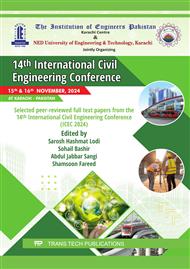[1]
S. Pathak, "Biomimicry: (Innovation Inspired by Nature)," International Journal of New Technology and Research, vol. 5, no. 6, 2019.
DOI: 10.31871/ijntr.5.6.17
Google Scholar
[2]
J. I. Ramos, "Alternate Realities: Mathematical Models of Nature and Man," Appl Math Model, vol. 14, no. 12, 1990.
DOI: 10.1016/0307-904x(90)90028-4
Google Scholar
[3]
I. Md Rian and M. Sassone, "Tree-inspired dendriforms and fractal-like branching structures in architecture: A brief historical overview," Frontiers of Architectural Research, vol. 3, no. 3, 2014.
DOI: 10.1016/j.foar.2014.03.006
Google Scholar
[4]
G. C. Mattheck, "Trees," 1991.
DOI: 10.1007/978-3-642-58207-3
Google Scholar
[5]
C. Cui and H. Yan, "An advanced structural morphosis technique - Extended evolutionary structural optimization method and its engineering applications," Tumu Gongcheng Xuebao/China Civil Engineering Journal, vol. 39, no. 10, 2006.
Google Scholar
[6]
C. Cui, B. Jiang, and G. Cui, "The sensitivity-based morphogenesis method for framed structures," Tumu Gongcheng Xuebao/China Civil Engineering Journal, vol. 46, no. 7, 2013.
Google Scholar
[7]
F. Otto, L. Glaeser, and N. Y. ) Museum of Modern Art (New York, The Work of Frei Otto. Museum of Modern Art, 1972. [Online]. Available: https://books.google.com.pk/books?id=VNlPAAAAMAAJ
Google Scholar
[8]
P. Von Buelow, "A Geometric Comparison of Branching Structures in Tension and Compression Versus Minimal Paths," IASS Conference Proceedings 2007– Shell and Spatial Structures: Structural Architecture – Towards the future looking to the past, no. May, 2007.
DOI: 10.1260/026635107781482659
Google Scholar
[9]
E. Gawell, "NON-EUCLIDEAN GEOMETRY IN THE MODELING OF CONTEMPORARY ARCHITECTURAL FORMS," The Journal of Polish Society for Geometry and Engineering Graphics, vol. 24, 2013.
Google Scholar
[10]
A. A. Khamees and K. K. Shadhan, "Experimental investigation of dendriform structure under static loading," Journal of Applied Science and Engineering, vol. 24, no. 1, 2021.
Google Scholar
[11]
K. R. James, N. Haritos, and P. K. Ades, "Mechanical stability of trees under dynamic loads," Am J Bot, vol. 93, no. 10, 2006.
DOI: 10.3732/ajb.93.10.1522
Google Scholar
[12]
B. B. Mandelbrot, "The fractal geometry of nature /Revised and enlarged edition/," New York, 1983.
Google Scholar
[13]
R. G. Black and A. Astaneh-Asl, "Design of Seismically Resistant Tree-Branching Steel Frames Using Theory and Design Guides for Eccentrically Braced Frames," International Journal of Civil and Environmental Engineering, vol. 8, no. 2, 2014.
Google Scholar
[14]
L. Hui-Jun, W. Zheng-Zhong, and L. Zhan-Chao, "Reliability and Sensitivity Analysis of Dendriform Structure," http://dx.doi.org/10.1260/0266-3511.28.2.75, vol. 28, no. 2, p.75–86, Jun. 2013.
DOI: 10.1260/0266-3511.28.2.75
Google Scholar
[15]
X. Peng, "Structural Topology Optimization Method for Morphogenesis of Dendriforms," Open Journal of Civil Engineering, vol. 06, no. 04, 2016.
DOI: 10.4236/ojce.2016.64045
Google Scholar
[16]
S. Dixit, A. Stefańska, and A. Musiuk, "Architectural form finding in arboreal supporting structure optimisation," Ain Shams Engineering Journal, vol. 12, no. 2, p.2321–2329, Jun. 2021.
DOI: 10.1016/J.ASEJ.2020.08.022
Google Scholar
[17]
J. Hunt, W. Haase, and W. Sobek, "A design tool for spatial tree structures," Journal of the International Association for Shell and Spatial Structures, vol. 50, no. 160, 2009.
Google Scholar
[18]
F. Fu, "Design and Analysis of Complex Structures," Design and Analysis of Tall and Complex Structures, p.177–211, 2018.
DOI: 10.1016/B978-0-08-101018-1.00006-X
Google Scholar
[19]
X. Peng, "Morphogenesis of dendriforms based on continuum structural topology optimization," Jianzhu Jiegou Xuebao/Journal of Building Structures, vol. 39, no. 3, 2018.
Google Scholar
[20]
Q. Zhang, Z. Chen, X. Wang, and H. Liu, "Form-finding of tree structures based on sliding cable element," Tianjin Daxue Xuebao (Ziran Kexue yu Gongcheng Jishu Ban)/Journal of Tianjin University Science and Technology, vol. 48, no. 4, 2015.
Google Scholar
[21]
Y. Wu, J. Fang, C. Wu, C. Li, G. Sun, and Q. Li, "Additively manufactured materials and structures: A state-of-the-art review on their mechanical characteristics and energy absorption," Int J Mech Sci, vol. 246, May 2023.
DOI: 10.1016/j.ijmecsci.2023.108102
Google Scholar
[22]
C. Xu, Z. Wang, B. Li, and Q. Liu, "Form-finding and shape optimization of bio-inspired branching structures based on graphic statics," Structures, vol. 29, p.392–407, Feb. 2021.
DOI: 10.1016/J.ISTRUC.2020.11.028
Google Scholar
[23]
G. Tu, C. Chen, Z. Gong, and Y. Wang, "A form-finding method for branching structures based on dynamic relaxation," Applied Sciences (Switzerland), vol. 11, no. 15, 2021.
DOI: 10.3390/app11157165
Google Scholar
[24]
ASTM Int., "A533/A533M − 16 Standard Specification for Pressure Vessel Plates, Alloy Steel, Quenched and Tempered, Manganese-Molybdenum and Manganese-Molybdenum-Nickel," Astm, 2016.
DOI: 10.1520/a0533_a0533m-93r04e01
Google Scholar


